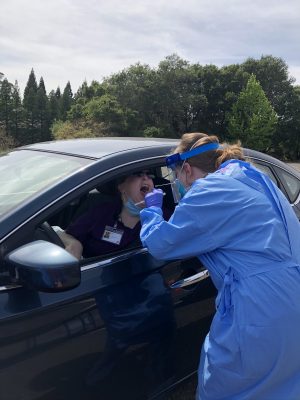California doesn’t yet have an organized structure to support people ordered to self-isolate or quarantine at home to prevent the spread of the coronavirus. IsoCare aims to change that.
In March 19 of this year, family medicine doctor Panna Lossy of Santa Rosa Family Medicine Residency volunteered to work at a drive-through test clinic for COVID-19. She spent hours in the parking lot of Santa Rosa Community Health swabbing patients with symptoms of coronavirus and giving them a handout about self-isolation. She was talking with her umpteenth person when she was struck by an overwhelming sense of futility.
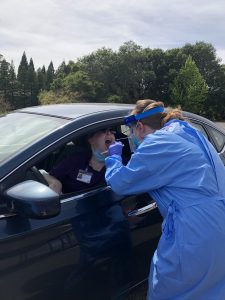
A physician swabs a patient for COVID testing in a parking lot at Santa Rosa Community Health.
“I was giving people a piece of paper about how to do self-isolation, knowing full well they were going to go to Costco to pick up supplies on the way home, and the driver was going to go to work the next day and possibly spread the infection to his colleagues,” Lossy recalls. “And how did we know that? Because patients were telling us so! I’d hand them the information about home isolation and they would say, “I’ve been isolating myself for weeks – I have just two more stops to make before I go home.”
Of course, those few trips potentially exposed others to COVID-19, which defeats the whole purpose of self-isolation. It was obvious that patients didn’t understand the county guidelines for self-isolation. Equally important, they really couldn’t do it by themselves – they needed help getting basic needs such as food and toilet paper delivered.
It was there, in the parking lot, that inspiration came. “I thought, what if there was a team to provide support to patients who need to self-isolate?” Lossy recalls. “What if we could provide education and help them problem-solve – to figure out how to get them food, masks and other stuff from Costco so they wouldn’t need to leave the house? We need to give them as much help as we can to prevent them from spreading the virus to others in their house! What if we could create a safety net for people who can’t self-isolate safely?” And that’s how IsoCare was born.
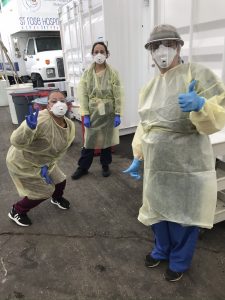
Dr. Panna Lossy (right) and colleagues during drive-by testing for COVID.
It wasn’t the first time that Lossy had tackled gaps in healthcare during a disaster. When wildfires engulfed Sonoma County in 2017, she was shocked to find a high school evacuation center filled with hundreds of frail, elderly and disabled people in their nightclothes, most of whom had arrived without their glasses, walkers, medications or medical records. She and other volunteers created a makeshift clinic in the gym so local hospitals wouldn’t be overwhelmed and went on to organize shifts of medical workers for other shelters throughout the county.
Fast forward to the COVID crisis. As the pandemic claimed tens of thousands of people in other states, Lossy felt it was critical to slow the spread of the virus in Sonoma County. As she envisioned it, IsoCare would educate patients required to self-isolate, problem-solve with them, and connect them with community resources to help them protect their household, friends, and neighbors.
A former Peace Corps volunteer in Thailand, Lossy spent hours over the next few days after her job teaching residents in virtual huddles with Dr. Deirdre Bernard-Pearl, a pediatrician, trauma expert and Pediatric Medical Director at Santa Rosa Community Health; they are both fellows in the California Health Care Foundation’s Clinical Leadership program. They were joined by Margaret Howe, former associate director of The Ceres Project, who became the CEO and what Lossy calls “the all-around brain of the organization.” Tech expert Aurora Williams became the volunteer coordinator and IT specialist, and volunteer Karen Mitchell agreed to serve as the ad hoc COO. Matt Taylor of the Taylor Group with the help of Sam Nelson donated the creation of an interactive phone bank tool (Sirus Activist), with scripts created by IsoCare.
As soon as Lossy put out the word to her network, “things happened incredibly fast,” she recalls. Dozens of retired doctors and nurses volunteered to make calls to patients; IsoCare organized volunteer signups by using the software tool SignUp Genius. The organization used the website Aunt Bertha get referrals from the community health centers. Finally, IsoCare linked clients to community-based organizations that provide social needs such as housing, food and rental assistance. In just under 10 days — and with zero dollars in funding — IsoCare was up and running.
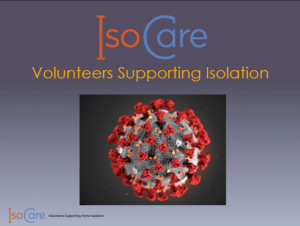
“A serious risk of spread”
Supporting home isolation is key to controlling the spread of COVID-19, explains Lossy. IsoCare works with patients who doctors think need to home isolate because they have tested positive for COVID-19, are being tested because they had symptoms of the virus, or those who have classic symptoms but didn’t meet the criteria to get tested. To prevent the spread of the virus, Lossy explains, all those people need to self-isolate at home and their close contacts need to quarantine.
IsoCare’s volunteers, she says, “have already made important public health interventions, such as alerting the public health department about a situation where a member of a household with a known positive patient was working in a food-packing factory in close quarters with about 100 people,” she says.
The network receives referrals of patients ordered to self-isolate from clinics all over Sonoma Country. On the phone bank tool, the volunteers log onto the web and make calls to each patient in the queue. What they learned from their first 166 intake interviews was alarming: 56 percent of patients did not meet all the isolation requirements, and 10 percent of the cases were engaging in behaviors that posed a serious risk of spreading the virus, including some who had tested positive but were still going to work.
Dr. Sundari Mase, the public health officer of Sonoma County, has issued an emergency order that required physicians to order anyone likely to be infected with COVID-19 to isolate and their close contacts to quarantine. She also made violation of self-isolation a misdemeanor, but Lossy explained that many patients’ living conditions made it hard, if not impossible, for them to follow those orders.
For example, patients thought to be infected are not supposed to share a room or bathroom with non-infected people, but the intake survey showed that 42 percent of the patients had to use a shared bathroom. Other families had run out of basic supplies such as diapers and food and had no one they could call on for delivery.
COVID-19 has hit Black, Latino, and Native American communities particularly hard. The disparate impact of the virus on communities of color, Lossy notes, has been evident in Sonoma County, where 72 percent of positive tests in Sonoma County are Latino even though they make up only 27 percent of the population. Concentrated in low-paying “essential work” jobs, Latinos may be less likely to have the financial resources to isolate safely and live in crowded spaces. “There is so much more we could do – we need to give people food, cleaning supplies, thermometers, masks and money to stay home,” says Lossy. “We need to come with a framework of support to help people do this really hard thing protect others.”
“It’s a question of social justice,” continues Lossy. “It’s not that patients don’t want to cooperate, but often that they can’t.” Helping them understand what they can do to at home to protect their families from getting COVID-19 is key to breaking the chain of household spread. “We talk people through the key things – opening windows, staying in a room alone, wearing a mask when they have to be in shared spaces, frequently cleaning high-touch surfaces, especially in the bathroom, and of course washing hands! And we help problem solve.” For people for whom it isn’t possible to isolate safely at home, Sonoma County has recently opened an Alternate Care Site at Sonoma State University.
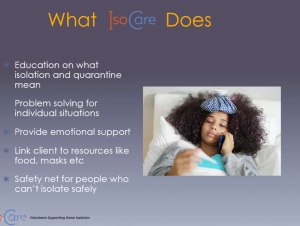
If patients need food or diapers and have no way to get them except to go to a grocery, for example, that’s what they will do, Lossy explains. “That’s is what IsoCare is set up to do – to solve these problems so the patients can stay home and get well without infecting others.”
Not surprisingly, the initiative involved a lot of upfront education. Patients were often confused about the orders. In the popular press, “quarantine” is often used interchangeably with “self-isolation,” but in health care, self-isolation applies to the sick person, who needs to isolate herself from other people for at 10 days inside a home, receiving meals through the door and using a separate bathroom. Other people in the home or who have been in close contact with them need to quarantine themselves just over 14 days – that is, to stay home for two weeks so that if they do have the virus, they won’t spread it to the public. (See the handout from the Sonoma County Department of Health for more details.)
In a recent webinar, IsoCare also takes care to explain that it is not a substitute for a patient’s physician, and it is not an arm of law enforcement.
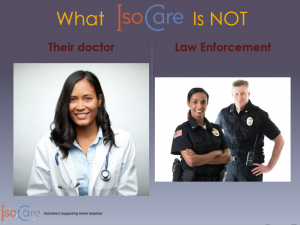
IsoCare’s key takeaways?
- Self-isolation and quarantine are extraordinarily hard to do – especially if you are poor and live with many other people.
- The post-testing handouts from providers made little impact. “It turns out that – no big surprise – that very few people had read the handouts on self-isolation.”
- Patients have less control over their circumstances than providers realize. If doctors want patients to stay home from work, for example, they have to give them a doctor’s note saying so; otherwise the patients are really in a bind.
The IsoCare volunteers work with patients and community organizations to solve seemingly intractable problems, such as how to get food when you’ve been ordered not to leave your house and have no credit card to use for food delivery. In some cases, that might mean finding a community organization that can deliver food and other supplies, or a pharmacy that can drop off medication at the front door.
In other cases, it might mean finding resources for rental assistance or securing a hotel room for an infected person who lives in cramped, crowded quarters. IsoCare often partners with other groups to keep the most vulnerable patients from falling through an increasingly tattered safety net and infecting everyone in their house.
“We have a sad situation in which two families of undocumented workers are living in close quarters in the same house,” Lossy says. “We already have seven positives [for COVID-19], and no one can go to work…They are super-stressed.” To aid the family and others in a similar plight, IsoCare is working with UndocuFund, which Lossy describes as “an amazing group.” Born to help undocumented farmworkers ineligible for FEMA aid, the organization has recently broadened its focus to include COVID-19 relief work.
In indigenous communities where COVID-19 is spreading especially quickly, a phone-based program like IsoCare might be able to provide valuable outreach according to Bernard-Pearl. “They’ve suffered from historical racism and violation of trust. If it comes from a volunteer working closely with their primary care medical home, the kind of telephone support IsoCare offers is especially helpful.”
“Social distancing is a privilege”
The importance of problem-solving during self-isolation is highlighted in a recent commentary piece on the American Academy of Family Physicians website. The author, Dr. MaryAnn Dakkak of Boston Hospital, reports that when hospitals send underserved patients home to self-isolate, entire families sometimes come down with the virus.
She writes of admitting “Nelson,” a young African-American man with COVID-19 and underlying conditions. He asked anxiously about his other family members hospitalized with the disease – something she was unaware of. As it turned out, his uncle had been sent home to self-isolate the week before, and the whole family had gotten sick.
The young man, who spent six days in Dakkak’s care before being intubated and put on a ventilator, was from a historically African-American neighborhood which, like other marginalized neighborhoods of color in Boston, had been hard hit by COVID-19 infection and mortality. In her op-ed, Dakkak explains there are many explanations for why this is the case:
“These areas contain concentrations of essential workers who cannot work from home or shelter in place. These neighborhoods have closer living spaces in multifamily housing. The housing is older and possibly less well ventilated. The residents often cannot afford to miss work, and many work essential service jobs that don’t allow them to stay home. Some are housekeepers, nannies or janitorial staff, working jobs where they are exposed to many other families and people…These factors, and many more, can increase the incidence of any infectious disease.”
As Dakkak observes, “Social distancing is a privilege.” Her safety net hospital asks patients a series of simple questions to figure out whether they have the luxury to shelter safely in place, but she worries that some feel pressured to say yes. All too often, she says, they come back sicker, with an ill friend or roommate in tow. “In the absence of widespread testing,” she concludes, “I worry that we continue to put patients’ families and communities at risk if we don’t give them better options for quarantine.”
Lossy agrees. “Dr. Dakkak really clearly captured how unfair the whole concept of home isolation is for poor people who have to physically go to risky jobs and then are told to stay in their isolated at home where the virus is likely to spread to their loved ones in a crowded home,” says Lossy. “Then to top that off, they are given very little education to how to do that most safely or actual support in the form of supplies, food or money.”
A vision of supporting contact tracing
Since its creation this spring, IsoCare has trained close to 150 volunteers and has worked with more than 750 patients and their families. Besides providing phone support, it has partnered with the Petaluma People Resources Center to offer services ranging from food delivery to counseling or vacuum repair.
“We’re a very small organization, and everyone is working so hard,” Lossy says. IsoCare leaders are doing weekly debriefs with their phone volunteers, scouring the county for more Spanish-speaking volunteers, and holding webinars with physicians in other California counties, many of whom were thrilled to learn about the program.
“IsoCare is brilliantly simple, a lovely and elegant solution,” said Dr. Jen Hastings of Santa Cruz, Calif., in a recent IsoCare webinar. “Your offer to share resources is really fantastic.” Physicians and nurses from Alameda County, Marin, and others were interested in expanding the program into their districts; a representative from the state department of health services was also enthusiastic.
IsoCare’s goal is to expand its program throughout California to support home isolation statewide, according to Bernard-Pearl.
“You probably noticed that when we asked what structures the other counties were doing to contain the spread of the virus, there was a silence,” Bernard-Pearl said. “In an ideal world, which I don’t actually live in, the government would have a whole robust plan to increase the number of people doing home isolation support. We have no real structure in place for containing COVID.” As such, she and the other IsoCare leaders would love to see IsoCare joining forces with CalREDIE and State Health Support to support not only isolation but contact tracing.
“We could retool the phone bank questionnaire to collect information that could be used in contact tracing,” says Lossy. “We could reach out to the department of health services to see what they would need. We stood this up quickly with no budget, but we wouldn’t use a volunteer workforce for a project of this magnitude. This would be a way to employ out-of-work healthcare providers or community health workers.”
Ultimately, it takes some digging to get to the real issues that needs to be solved to isolate and quarantine successfully. “You need to build trust and be able to offer resources,” Lossy concludes. “There is no substitute for human interaction.”
Learn More
- IsoCare. The website for IsoCare lives on the Disaster Crash Cart website, which is funded by the California Academy of Family Physicians, Northern California chapter. Donations to IsoCare can be made through the website and help fund safe home isolation.
- Data show COVID-19 is hitting essential workers and people of color the hardest, according to Data for Justice, a project of the ACLU of Massachusetts.
- “When Quarantining at Home Puts Families at Risk” by Dr. MaryAnn Dakkak
- Sonoma County Department of Health Services: Home isolation and quarantine instructions for people diagnosed with or suspected to have COVID-19 and their household or close contacts (PDF)
- SaludAmerica: Coronavirus and Latino Health Equity. An excellent collection of reports on Latinos, disparities, and health equity during the COVID crisis, including coronavirus case rates and death rates for Latinos in the United States and coronavirus’s disparate impact on job loss and stress among Latinos.
![]()
VOICES FROM THE FIELD: INNOVATING DURING THE COVID-19 CRISIS
This series is based on the extraordinary work that frontline health care staff are doing in the current public health emergency. Do you want to share a story about COVID-19 and the health care safety net? Please get in touch!
Find this useful or interesting? We’re constantly sharing stuff like this. Sign up to receive our newsletter to stay in the loop.

